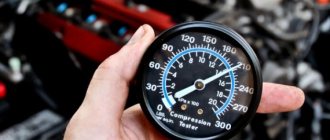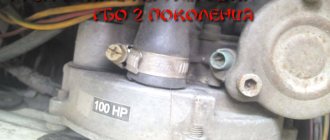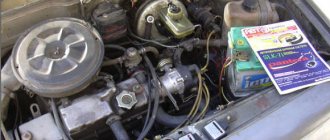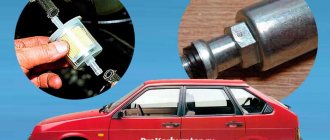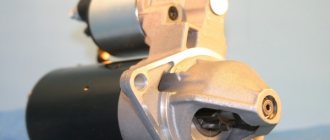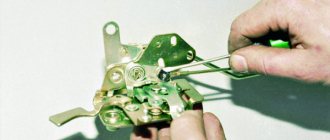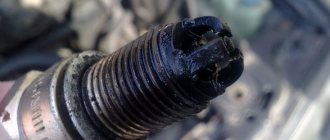The VAZ-2109 model with a carburetor engine is an unpretentious Russian car, characterized by a low price, economical fuel consumption, high maintainability, and very good technical characteristics. However, like any passenger car, it has its own characteristic “diseases”, one of them is that the engine starts and stalls, the carburetor overflows fuel. A similar malfunction occurs in various variants: the engine may stall while driving, the speed decreases when you press the gas pedal (and traction disappears), the engine stops when the car starts moving. Here we will try to consider all the main causes of the problem and the question of how such problems can be solved.
The main reasons for engine stopping while driving or after starting it
There are two main signs when an internal combustion engine (ICE) stalls:
- the motor stops almost immediately after starting (in place, without moving the car);
- the engine turns off (the speed drops to the very minimum) when you try to start moving or switch to a higher load.
The reasons for this behavior of the internal combustion engine are very different and sometimes unexpected; if the engine stalls, barely having time to start, this may be as a result of:
- lack of fuel supply (no gasoline entering the carburetor float chamber);
- somehow the ignition is turned off;
- idle speed disappeared;
- the fuel filter is clogged;
- a partition in the muffler blocked the exit of exhaust gases.
If there is no fuel supply, the fuel pump is most often to blame (on VAZ models 2108, 2109 and 21099 it is of a mechanical type).
To make sure there is fuel supply, you need to remove the central high-voltage wire, disconnect the main fuel pipe from the carburetor and crank it with the starter. If the used pump pumps, gasoline will immediately begin to flow out of the hose; this check should be carried out by two people.
Sometimes a situation arises when a partition inside the muffler blocks the outlet of exhaust gases, the engine “chokes” and does not work. When the exhaust is “half-covered,” the car simply drives poorly – sluggish acceleration, limited maximum speed. When the muffler pipe is completely blocked, the internal combustion engine starts and stalls almost instantly. Checking this version is quite easy:
- one of the diagnostic participants (also needs to be done together) starts the engine;
- the second person observes, placing his palm on the exhaust pipe, whether there is any exhaust of gases.
Another reason for the internal combustion engine to stop is the lack of idle speed in the carburetor; a similar defect is typical for front-wheel drive VAZs. At this point we will dwell in more detail and consider various options for the manifestation of the malfunction and ways to eliminate it.
Problems with idle speed of VAZ models 2108-09-099
VAZ cars of the “ninth” family are equipped with Solex carburetors; they differ in modifications depending on the engine size (1100, 1300 or 1500 cm³). Externally, the carburetor units (CU) are almost completely identical, the difference lies in the internal “filling”: jets of different cross-sections, an accelerator pump nozzle (APA), emulsion tubes, and diffusers are installed. The idle speed system (IDS) in these CUs is responsible for the stability of minimum engine speeds, as well as for fuel consumption.
The Solex XX system includes the following elements:
- channels for supplying fuel and air;
- air jet;
- solenoid valve (EMV) with fuel jet;
- speed screw;
- adjusting needle for the quality of the fuel-air mixture.
The quantity screw sets the position of the throttle valve, leaving it slightly open, and the fuel mixture at low speeds, under the influence of vacuum, enters the engine through the carburetor and passes through the XX channels. Dosing of the mixture is ensured by jets, enrichment or combination is ensured by an adjusting needle, and the fuel supply is controlled using an EMG.
If the solenoid valve does not operate, or the channels are clogged, fuel and air in the required proportions will not flow into the intake manifold, idle speed will disappear. Because of this, various problems occur during the operation of the internal combustion engine:
- the engine starts and stalls because there is no idle speed;
- even if there is XX, the engine still works unstable, and when you try to start moving, it stops;
- the car loses dynamics, and when you press the gas, on the contrary, the car picks up speed.
If, with such signs, you unscrew the EMG a little, the engine will gain speed at idle, but this method will not solve the problem - the car will still not drive normally, and besides, fuel consumption will increase.
How does an internal combustion engine work?
At the heart of any automobile engine is the process of converting the air-fuel mixture into exhaust gas that is many times larger in volume. During combustion of the mixture, various gases are released, which increase the pressure in the cylinder, causing the piston to push towards the crankshaft. We covered these processes in more detail, as well as various malfunctions associated with the technical condition of the motor itself, in these articles:
- The car stalls while driving.
- The car stalls at idle and low speed.
- The car stalls when hot.
- The car stalls when cold.
- The car starts and stalls, what is the reason.
- Why does a carburetor car stall?
Therefore, further we will only talk about why a car with an injector stalls, without being distracted by other types of engines.
What to do if idle speed disappears
If the car is unstable at idle, drives with dips, or constantly stalls, first of all you need to check the functionality of the solenoid valve. We check it as follows:
- we start the engine at low speed, and to prevent the engine from stalling, use the quality screw to add speed;
- with the internal combustion engine running, without pressing the gas pedal, pull off the EMG wire plug;
- if the nature of the work has not changed, you need to check the presence of power on the EMG; to do this, turn off the engine, turn on the ignition, and bring the chip with the wire to the valve. If there is voltage, a slight click should be heard (to hear it better, you can repeat the test several times).
If there is no power, most likely the economizer control unit has failed, or there is a bad contact somewhere in the wiring (probably a break). This problem needs to be fixed; it is possible that the reason for the absence of XX is hidden here.
But let’s say there is voltage on the valve, but the fault is still present. Now we need to check the operation of the valve itself, we perform this operation like this:
- remove the fuel jet from the EMG;
- We fix the valve body to the ground terminal of the battery, and apply plus to the EMG contact (you can also use it from the battery using a piece of wire);
- when the “plus” is applied, the solenoid valve needle should be retracted (triggered); if this does not happen, then the valve is faulty.
The engine stalls regularly - the throttle position sensor is broken
Regular stopping of the car engine may indicate that the problem is a malfunction of the throttle sensor. This sensor measures the force when you press the gas. The data goes to the ECU (electronic control unit) of the propulsion system. The volume of fuel that should be injected into the combustion chamber of the engine is calculated.
This operation is carried out unnoticed by the driver, in a split second.
If the damper sensor provides erroneous information, injection of the required amount of fuel may not occur. This moment can often be observed when the driver presses the gas pedal. Only a mechanic can perform a quality check of the functioning of the sensor. This requires special knowledge.
As an additional signal, you can pay attention to the “Check Engine” indicator. If it lights up, then it can be assumed that there is a breakdown of the throttle sensor.
Effect of air leaks in the fuel system
Unstable operation of the internal combustion engine, failures during acceleration of the car can also occur due to air leaks in the fuel system (TS), because as a result of the appearance of excess air mass, the proportion of the mixture necessary for the complete combustion of gasoline in the cylinders is disrupted. Air suction can occur:
- between the top cover and the main body of the carburetor due to metal deformation;
- due to a loose fit of the lower platform of the HRSG to the intake manifold;
- as a result of a rupture of the hose or its poor connection with the fittings of the vacuum brake booster (VUT);
- due to a malfunction of the vacuum booster itself.
It is quite easy to check whether VUT affects the stability of the engine; you need to disconnect the “vacuum” hose from the intake manifold, plug the fitting, and start the engine.
If, after installing the plug on the fitting, the engine operation is leveled out and it no longer “trips”, we have correctly identified the cause of the malfunction. Sure signs of leakage in such cases: a noticeable hiss of air in the area of the “vacuum chamber”, engine stopping or a sharp drop in speed after pressing the brake pedal. The power mode economizer (EMR) also affects the stability of the idle speed; more precisely, its diaphragm, if it is broken, the engine will not work normally at low speed. In any case, it is worth checking the condition of this part; you can remove the diaphragm without dismantling the carburetor (unscrew 3 screws).
see also
- The engine stalls when you press the brake on a VAZ 2109
- Why does the oil pressure light on a VAZ 2106 come on at idle?
- Modification of the rear lights of the VAZ 2107
- Why does the VAZ 2109 jerk when accelerating?
- What kind of battery is needed for a VAZ 2107
- VAZ 2107 sorcerer operating principle
- VAZ 2106 shoots into the muffler
- How to remove the instrument panel on a VAZ 2106
- How to make a VAZ 2106 taller
- VAZ 2101 procedure for pumping brakes
- The glass of the VAZ 2109 rises slowly
The influence of the accelerator pump on the operation of the VAZ-2109 internal combustion engine
Unstable engine operation, stalls, sluggish acceleration, etc. can also occur due to malfunctions in the Solex accelerator pump system. Here are the main causes of problems on the “nine”:
- incorrect dosage of the sprayer (“spout” or “elephant”), as well as clogging of this channel;
- torn or dried out diaphragm;
- incorrectly selected accelerator pump drive (“flag”).
Factory nozzles for the “nine” usually have two “spouts”, which are distributed among the chambers, but in the “secondary” fuel injection turns out to be completely unnecessary, at least that’s what many craftsmen think. The modernization of this part is the transfer of both “spouts” to the “primary chamber” (primary chamber), another option is the installation of a single sprayer from the KU for the Niva.
When bending the tubes, it is important to install them so that the injection passes exactly between the carburetor body and the damper, without hitting these parts, otherwise there will be no effect from such tuning.
The injection is checked, of course, with the carburetor removed, without the top cover, with the float chamber filled with gasoline. When you open the throttle (simulating pressing the gas pedal), you should get two even jets that pass through the lower part of the body without hitting it.
Carburetor power units are actually a thing of the past. But many cars on the roads of our country still use this option for supplying fuel to the engine. For many, a carburetor turns out to be a fairly convenient means of replacing an injector, since the car becomes easier to repair and cheaper to operate. In most cases, the owner of a carburetor car can independently carry out basic maintenance work on the fuel supply system. In the case of an injector, this task should only be performed by specialists. For simple carburetor repairs, you do not need special equipment, but to work with an injector, such devices are simply necessary. Therefore, such a part of the engine power system has certain advantages. Interestingly, these advantages force many to change the injector to a carburetor, which is not difficult at all.
Problems that arise with the carburetor can be very different. One of the common problems is that the engine stops working after the car has completely warmed up. The driver has to increase the speed with the help of a choke, but this trick will not work on carburetors with auto-choke. Eventually, the engine will stall as soon as you release the gas pedal. At every traffic light, intersection and pedestrian crossing, the driver begins to curse fate, red lights and innocent pedestrians, and the carburetor continues to stall and refuses to work normally, despite very expensive gasoline. Let's figure out the nature of this trouble.
Wear of sealing gaskets
The design feature of the engine requires the presence of sealing gaskets. They make the engine structure more airtight. If the gaskets in the area of the manifold or cylinder block are worn out or have lost their tightness, then when you press the gas pedal, the engine may stall.
If the gasket burns out, coolant penetrates into the engine in the area of the cylinder block. In this situation, the engine continues to operate, but the number of revolutions decreases sharply. You may notice white smoke coming from the exhaust pipe.
The driver, faced with the problem of turning off the engine, finds himself in an extremely unpleasant situation. In order to eliminate this difficulty, you need to know the reason for its occurrence.
Why might the carburetor stall after warming up?
To understand the cause of this problem, it is best to contact motorists who have already encountered such a problem. Whatever happens to your car, remember that similar problems have most likely happened to other car owners. Therefore, you should visit specialized forums or simply chat with other motorists. In this case, you can find several options for answering your question. After warming up, the carburetor completely closes the choke valve, leaving the accelerator valve in working condition. If the idle speed is set incorrectly, the engine will only run on choke. But this is the basic reason; there are several other popular problems:
- rapid engine overheating and serious problems with the cooling system of your power unit;
- very poorly adjusted valves - adjustment has not been made for several years in a row;
- the carburetor is not adjusted, the mixture is too lean, the system blows too much air into the combustion chamber;
- the mixture can also be overly rich, which causes fuel overflow and problems in some carburetors;
- the carburetor jets are clogged, fuel flows poorly through them, which causes problems in the quality of the mixture;
- gasoline is incredibly bad, the filters are clogged, the flow rate of the fuel system has become much lower;
- Certain problems have arisen inside the carburetor, membranes and gaskets have broken, and fuel is leaking.
We carry out diagnostics and repair work on the carburetor ourselves
You can take advantage of excellent carburetor work if you know its design and have already dealt with simple repair processes. Otherwise, we do not recommend that you try recovery on your own. Ultimately, such repairs will cost much more than they could cost from specialists. If you have experience and confidence in your skills, you can use the advice of specialists to perform a high-quality restoration of your car. Among the main work that will have to be carried out, the following processes can be identified:
- remove the carburetor cover with the air filter and try to start the car, as it warms up, lower the choke and look at the position of the dampers, perhaps adjusting them will be enough to restore the car’s operation;
- if this does not help, look at the functioning of the fuel system; perhaps the fuel pump stops pumping fuel after a certain period of normal operation;
- also examine the cooling system, regardless of what the gauges on the dashboard say, look at the antifreeze level, make sure the thermostat is working correctly;
- you can also change the air and fuel filters to make sure that fuel and air enter the carburetor without problems and in sufficient quantities;
- the last stage of work is the removal and disassembly of the carburetor to install a repair kit, new gaskets, membranes and other parts, as well as to clean this device from contamination.
You can think for a long time about what the problem really is, or you can simply go to an automotive supply store, buy a carburetor repair kit that is installed under the hood of your car, carry out the necessary work and get the cleanest operation of the power unit. This is the only way you can get high-quality operation of the equipment and no problems with the power unit. After diagnostics and corrective work, the carburetor will definitely stop tormenting you with constant stoppage of operation. This will allow you to operate the car efficiently and safely.
Ignition problem
If the car has ignition problems, the spark is very weak. If you press the gas sharply, the spark plugs are filled. The spark plugs are lit and the spark fades.
It is not difficult to test this hypothesis. When unscrewing the spark plug, it will become noticeable that it is wet. If there is a suspicion that there is a problem with the ignition, it is necessary to check the entire system.
Long-term service of spark plugs can lead to problems such as penetration into the housing.
Checking high voltage wires can be done using a spare kit. If it is missing, you can start the engine at night by looking under the hood. If the wires are damaged, current discharges may occur.
If a breakdown such as the car stalling when you press the gas is a frequent occurrence, then it is better to seek help from professionals.
Carburetor repair by specialists is the best solution
If you have a carbureted car, it would be best to find a professional who can service the equipment regularly. Your car will require high-quality maintenance on a regular basis, since the carburetor is constantly becoming clogged and presents more and more problems in operation. Therefore, it would be best to use the services of a specialist who knows his business very well and performs cleaning, regular maintenance and repair of carburetors, as well as all related equipment. The main criteria for choosing a specialist are as follows:
- experience in working with your car model, sufficient professionalism, confirmed by years of work;
- positive reviews from other owners of carburetor cars who received quality service;
- affordable prices - you don’t have to choose an expensive service station, you can cooperate with a private master;
- fairly quick completion of all necessary repair work, but the presence of a guarantee of the quality of the result;
- the possibility of ordering complex work with the purchase of spare parts performed by a specialist in order to relieve oneself of responsibility for the quality of parts;
- other convenient services, as well as the possibility of full vehicle maintenance.
It is convenient when all repairs and maintenance are carried out by one person. This makes it quite easy to get a high-quality working car, since one person or one company is responsible for it. If one person repairs your carburetor, another person maintains the car, and a third person solves problems with the generator, all this is not very convenient for repair work on the car. So it’s better to find a universal specialist and constantly service the car exclusively from him. If you have a Solex carburetor installed on your car, we suggest watching a video about its disassembly and maintenance:
Let's sum it up
Fine cars with carburetor engines have become industrial history, but they are still widely represented on the roads. That is why you can use the ideas presented in this publication, since there are still a lot of carburetor masters, and you can find the necessary spare parts in stores. If your car has problems with the quality of the fuel supply system, it’s time to fix all these problems. You can quite easily obtain high quality operation of the power unit and fuel system if you simply take care of all the important components of the car.
For the carburetor to work properly, it simply needs to be cleaned occasionally. This point is quite important for every car operating in Russia. Fuel quality, atmospheric pollution - all this affects the normal operation of the engine. It is enough to carry out a high-quality cleaning of the fuel supply system every few years by performing certain maintenance processes to ensure long-term and high-quality operation of all engine systems. How did you maintain a carburetor car?

